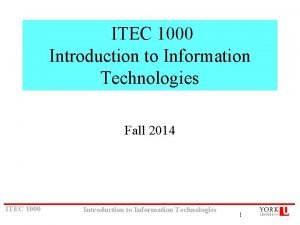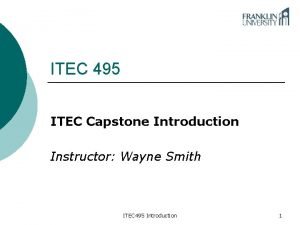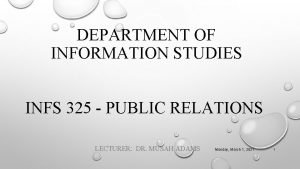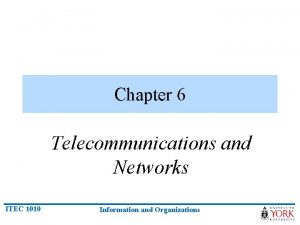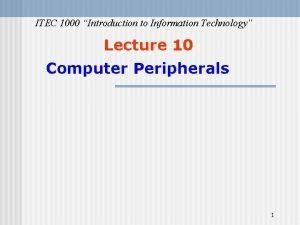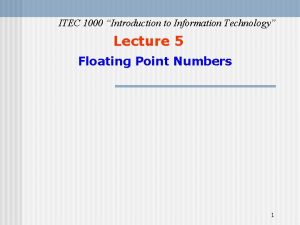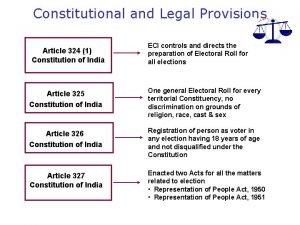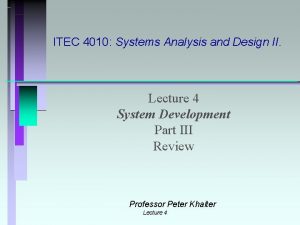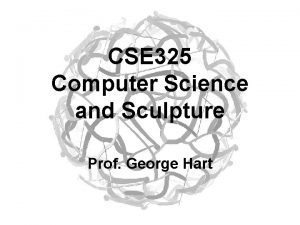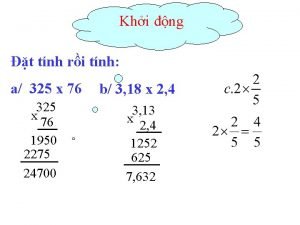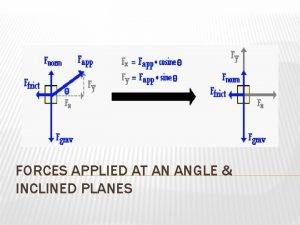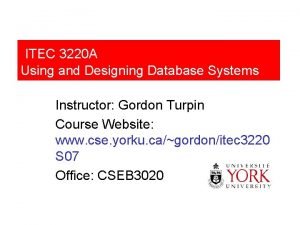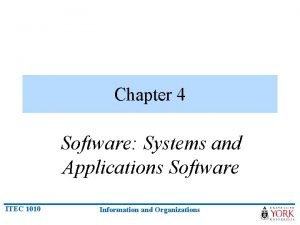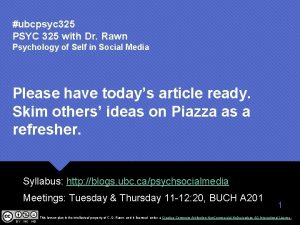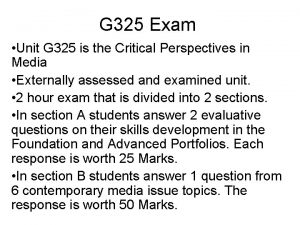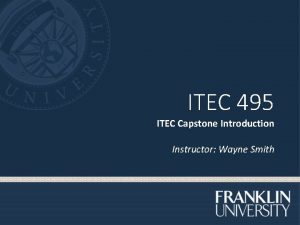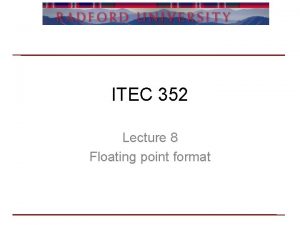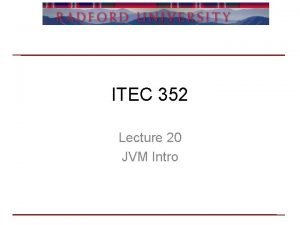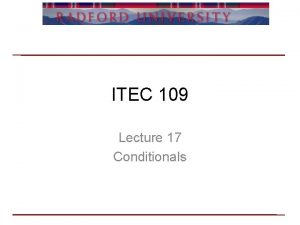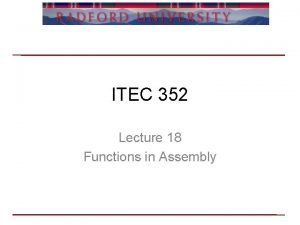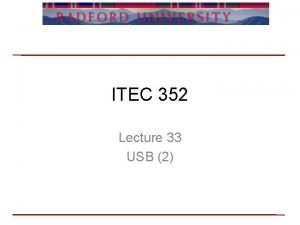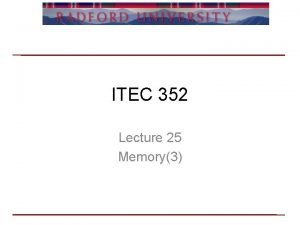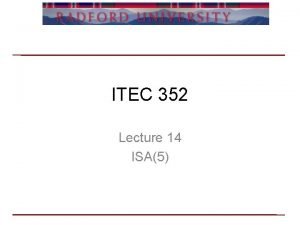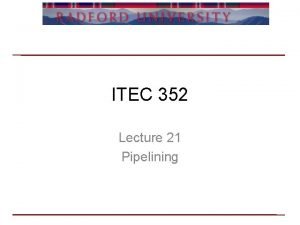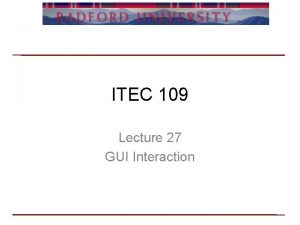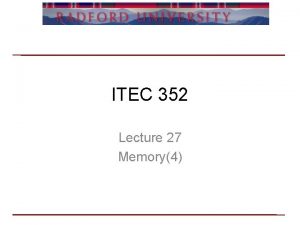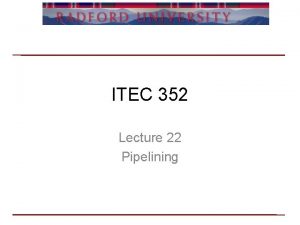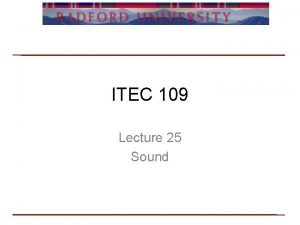ITEC 325 Lecture 28 Memory5 Review P 2





















- Slides: 21

ITEC 325 Lecture 28 Memory(5)

Review • • • P 2 coming on Friday Exam 2 next Friday Operating system / processes Logical address / physical address Pages / frames Main memory HD Memory (5)

Demand Paging • Some programs hog memory resources: they are huge and eat up too much physical memory. • Most systems attack this problem by only bringing into the physical memory portions of the process that are actually needed. • • In other words, some pages in the process are not loaded into the physical memory – as long as they are not needed. This is called demand paging. Memory (5)

Page Table – • The page table maps between virtual memory and physical memory. Memory (5)

Address translation – Closer look at translating a virtual address into a physical address: Contains a present bit Memory (5)

Demand Paging: only bring in the pages that are needed (e. g. , page 7 for program A is not needed). © Silberschatz and Galvin

Page Table When Some Pages Are Not in Main Memory © Silberschatz and Galvin

Accessing when not in memory • If there is a reference to a page, first reference to that page will trap to operating system: • page fault n Operating system looks at another table to decide: – Invalid reference abort – Just not in memory n Get empty frame – what if no empty frame found? n n Swap page into frame Reset tables Set present bit = 1 Restart the instruction that caused the page fault Memory (5)

Steps in Handling a Page Fault © Silberschatz and Galvin

Performanc e • Page Fault Rate 0 p 1. 0 – if p = 0 no page faults – if p = 1, every reference is a fault Effective Access Time (EAT) EAT = (1 – p) x memory access + p (page fault overhead + swap page out + swap page in + restart overhead Memory (5)

Example • Memory access time = 200 nanoseconds • Average page-fault service time = 8 milliseconds = 8000000 nano seconds • EAT = (1 – p) x 200 + p (8 milliseconds) • = (1 – p) x 200 + p x 8, 000 • If no page fault (p = 0), then EAT = 200 nano seconds • If one access out of 1, 000 causes a page fault, then • EAT = 8. 2 microseconds. = 8200 nanoseconds • This is a slowdown by a factor of 41!! • Hence, we need to reduce the number of page faults. Memory (5)

Performanc e of paging • Two factors effect performance: • • (a) Number of page faults: (b) Fast access to the page table. Next: Decreasing the number of page faults. Memory (5)

Decreasing page faults. • To reduce the number of page faults, a key factors is what pages to replace when a page fault occurs. – Two common algorithms: • Least recently used • First in First out. • Optimal page replacement – replace the page that will not be used for the longest period of time. Memory (5)

Example • When running a process, its virtual memory was divided into 9 pages. However, there is only free space for 4 pages in the physical memory. • Here is the order in which the pages are being accessed as the process executes: – 7, 0, 1, 2, 0, 3, 0, 4, 2, 3, 0, 3, 2, 1, 2, 0, 1, 7, 0, 1 – How many page faults occur with the: • Optimal page replacement algorithm? • Least Recently Used? – Exercise in class…. Memory (5) © Silberschatz and Galvin

Faster implementation • Use a separate cache (other than L 1, L 2) to store a part of the “page table”. – Called Translation look aside buffer (TLB): • TLB is – Hardware implementing associative memory • Associative memory: similar to a hash table. • Working of a TLB: – First use page number to index into TLB, • If page number found (TLB hit), read associated frame number – This is faster than memory lookup since TLB is hardware implemented. • If page number not found (TLB miss), go to main memory Memory (5)

Paging Hardware With TLB © Silberschatz and Galvin

Advantage of TLB • When does TLB offer an advantage – When most of the page numbers the process refers to is in the TLB. – Determined by what is called as hit ratio – 0 <= hit ratio <= 1 – If hit ratio higher greater chance of finding page in TLB – Example: Let memory access time be 100 ns. Let TLB access time be 20 ns. Hit ratio: 0. 8. – What is the overhead of a lookup ? Memory (5)

Thrashing • Consider this scenario: – The CPU is idle, lots of processes are waiting to execute. – The OS (to increase multiprocessing) loads the processes into the pages. – Now let us say, a process starts using more memory. • • Then it demands free frames in main memory. What if there are no free frames? Solution: steal from other process. What if the other process needs more frames? – Processes start page faulting – this causes the OS to think that the CPU is idle and it loads even more processes causes more thrashing. – Example: the. NET runtime optimization service. © Silberschatz and Galvin Memory (5)

Putting it All Together • An example TLB holds 8 entries for a system with 32 virtual pages and 16 page frames. Memory (5)

Class exercise. • Consider a memory architecture that contains a TLB, an L 1 cache, an L 2 cache and main memory. • 30%: hit rate of TLB. • 90%: hit rate of L 1 cache • 95%: hit rate of L 2 cache • 10% page fault rate. • Also accessing – – – TLB: 10 ns L 1 cache: 15 ns L 2 cache: 100 ns Memory: 100 milliseconds. Time to process a pagefault = 200 milliseconds • What is the effective memory access time? (i. e. , for any logical address that the CPU requests, how long does it take on average to read the data at that address? Memory (5)

Summary • Paging • Faults • TLB Memory (5)
 01:640:244 lecture notes - lecture 15: plat, idah, farad
01:640:244 lecture notes - lecture 15: plat, idah, farad Itec 1000
Itec 1000 Doc pro star
Doc pro star Gestin itec
Gestin itec Theotokos vs christotokos
Theotokos vs christotokos Itec
Itec Infs 325
Infs 325 Itec 1010
Itec 1010 Dot pitch
Dot pitch Exponent mantissa
Exponent mantissa Article 325
Article 325 Nic borg
Nic borg Itec 4010
Itec 4010 Cse 325
Cse 325 A 325
A 325 Apes 325 template
Apes 325 template A box of books weighing 325 n
A box of books weighing 325 n Itec 3220
Itec 3220 Itec 1010
Itec 1010 Itec
Itec Peripheral and interfacing
Peripheral and interfacing Itec irrigation controller
Itec irrigation controller

